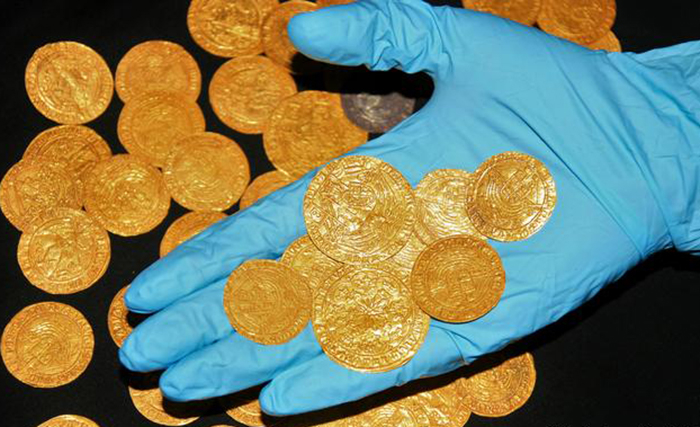
Treasure hunt is a national sport for the British. Some roam the fields with their metal detectors in search of coins, historical weapons or buried treasures.
During the first lockdown, however, between March and May of this year, treasure hunting with metal detectors was banned altogether. And in the current blockade, there are strict rules around practice as well. Thus, treasure hunters began to live in gardens or even the houses where they lived.
And they were successful: 47,000 such findings were recorded in 2020, according to the British Museum, including 6,251 during the ban, from March to May. There was a significant increase in findings at the museum itself, the museum added.
Hidden treasures and curiosity
There are some truly notable finds in the finds, such as a collection of coins from the time of the House of Tudor, who ruled the Kingdom of England in the 15th and 16th centuries.
The collection consists of 63 gold coins and one silver coin, all dating from the late 15th century to the 16th century. It was presumably buried around 1540. Who discovered that it was a family in the New Forest in the south of England? “Wholly coincidentally, while weeding.
The Treasury contains four coins from Henry’s 8th reign, bearing the early names of his wives Catarina de Aragon (K), Ana Bolin (A) and Jane Seymour (I).
According to the British Museum, it is not yet known whether the treasure that was already valuable at the time of the coins ended up in the garden. Most likely, he was buried there.
It is also not clear whether 50 Krugerand solid gold coins minted during apartheid rule in South Africa in the 1970s ended up in a garden in Milton Keynes, northwest of London.
There is another mystery, a medieval seal mold made of lead alloy and found in Dursley, Gloucestershire. He shows a bishop in a robe and holds a staff in his left hand. A Latin inscription identifies him as David, Bishop of St. Andrews.
But everything indicates that this is a fake term, probably used to authenticate false documents. Such genuine stamp molds were not made of lead but made of copper or silver alloys. Apparently, someone had to get rid of the fake and threw the copy away.
In Old Basing, in English county Hampshire, a Roman furniture ornament made of copper alloy was found. It dates from 43 and 200 years and is decorated with an incredibly well-preserved face of the Greek god Ocean.
The extension includes the bearded face of the deity created by seaweed. Small dolphins swim under the ears to Osho’s chin, while snake-like creatures rest on either side of the Lord’s temples.
This discovery is unique, since such marine motifs were never found in chests, doors, or residential furniture since that time.
All findings must be reported
Treasure hunting is so popular in the UK that it is also served as the setting for a popular TV series Detectorists. But there are very clear rules in the country about what is considered a treasure and what authority they seek.
By law, treasure hunters are required to report what they find to local authorities, who then conduct an archaeological analysis of the search site, to ensure that the historical context is not lost.
A treasury valuation committee determines the value of the item and who is entitled to a portion of the search and in what amounts.
Those who break the law by finding treasure, for example by attacking someone else’s property, are not entitled to any reward. And museums always have priority when purchasing archived items.
Making the treasure accessible to all
The annual list of all archaeological discoveries is made available to the public by the British Museum in its online database, the Portable Antiquities Scheme (PAS). The portal includes free access information on over 1.5 million items.
Archaeological discoveries should not be held by those who found them, because sometimes even small discoveries lead to very large discoveries or entire archaeological sites.
It was also accompanied by an Iron Age settlement and a Roman settlement found in Kent and an Anglo-Saxon cemetery in Lincolnshire.
News bulletin
Do you want to receive news from Domtotal in your email or WhatsApp?



